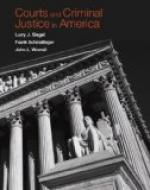“Are you acquainted with the accused or his family?” mildly inquires the assistant prosecutor. “No—not at all,” the talesman may blandly reply.
The answer, perhaps, is literally true, and yet the prosecutor may be pardoned for murmuring
“Liar!” to himself as he sees that his memorandum concerning the juror’s qualifications states that he belongs to the same “lodge” with the prisoner’s uncle by marriage and carries an open account on his books with the defendant’s father.
“I think we will excuse Mr. Ananias,” politely remarks the prosecutor; then in an undertone he turns to his chief and mutters: “The old rascal! He would have knifed us if we’d given him the chance!” And all this time the disgruntled Mr. Ananias is wondering why, if he didn’t “know the defendant or his family,” he was not accepted as a juror.
Of course, every district attorney has, or should have, information as to each talesman’s actual capabilities as a juror and something of a record as to how he has acted under fire. If he is a member of the “special” panel, it is easy to find out whether he has ever acquitted or convicted in any cause celebre, and if he has acquitted any plainly guilty defendant in the past it is not likely that his services will be required. If, however, he has convicted in such a case the district attorney may try to lure the other side into accepting him by making it appear that he himself is doubtful as to the juror’s desirability. Sometimes persons accused of crime themselves, and actually under indictment, find their way onto the panels, and more than one ex-convict has appeared there in some inexplicable fashion. But to find them out may well require a double shift of men working day and night for a month before the case is called, and what may appear to be the most trivial fact thus discovered may in the end prove the decisive argument for or against accepting the juror.
Panel after panel may be exhausted before a jury in a great murder trial has been selected, for each side in addition to its challenges for “cause” or “bias” has thirty* peremptory ones which it may exercise arbitrarily. If the writer’s recollection is not at fault, the large original panel drawn in the first Molineux trial was used up and several others had to be drawn until eight hundred talesmen had been interrogated before the jury was finally selected. It is usual to examine at least fifty in the ordinary murder case before a jury is secured.
* In the State of New York.
It may seem to the reader that this scrutiny of talesmen is not strictly preparation for the trial, but, in fact, it is fully as important as getting ready the facts themselves; for a poor jury, either from ignorance or prejudice, will acquit on the same facts which will lead a sound jury to convict. A famous prosecutor used to say, “Get your jury—the case will take care of itself.”




